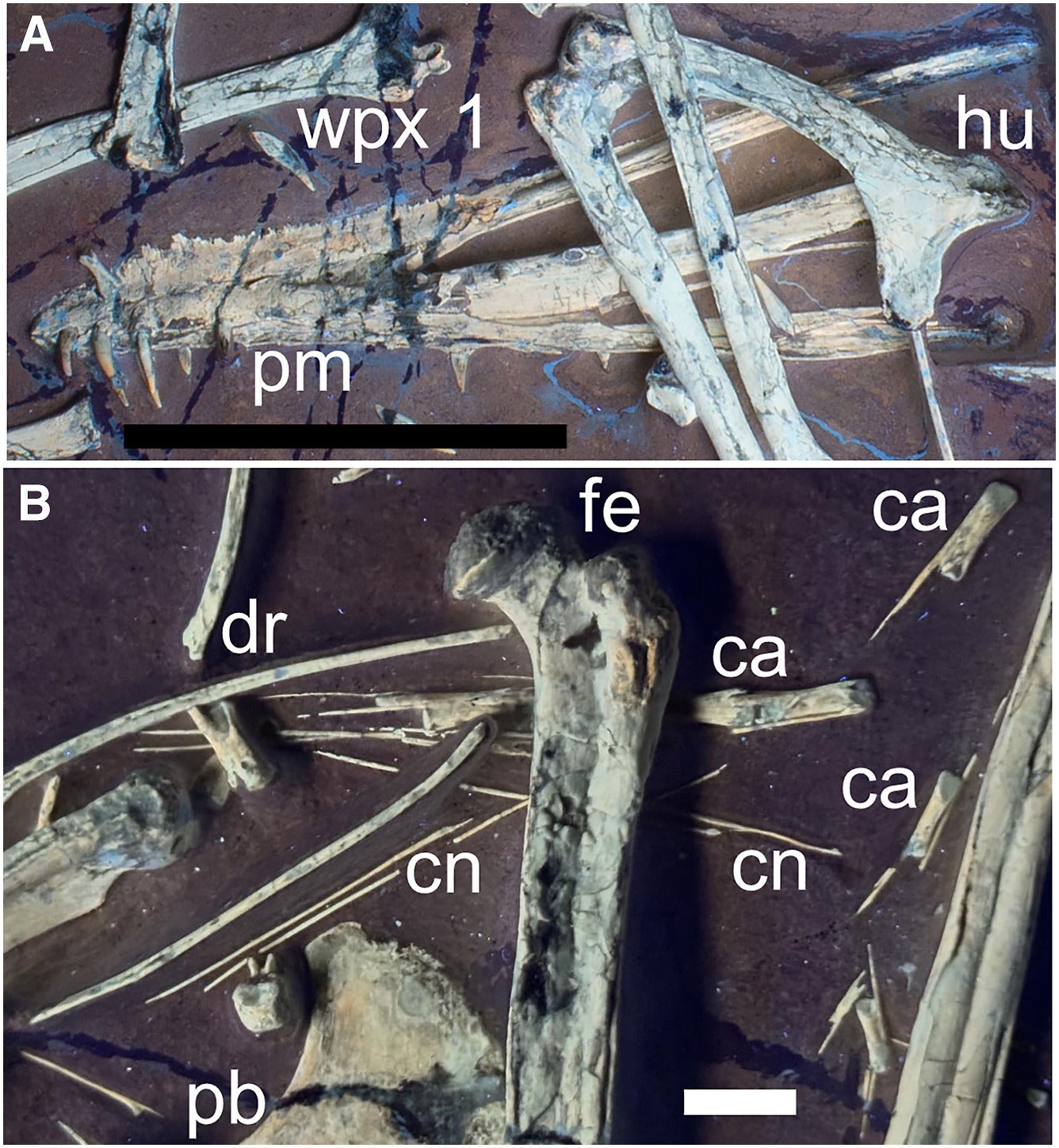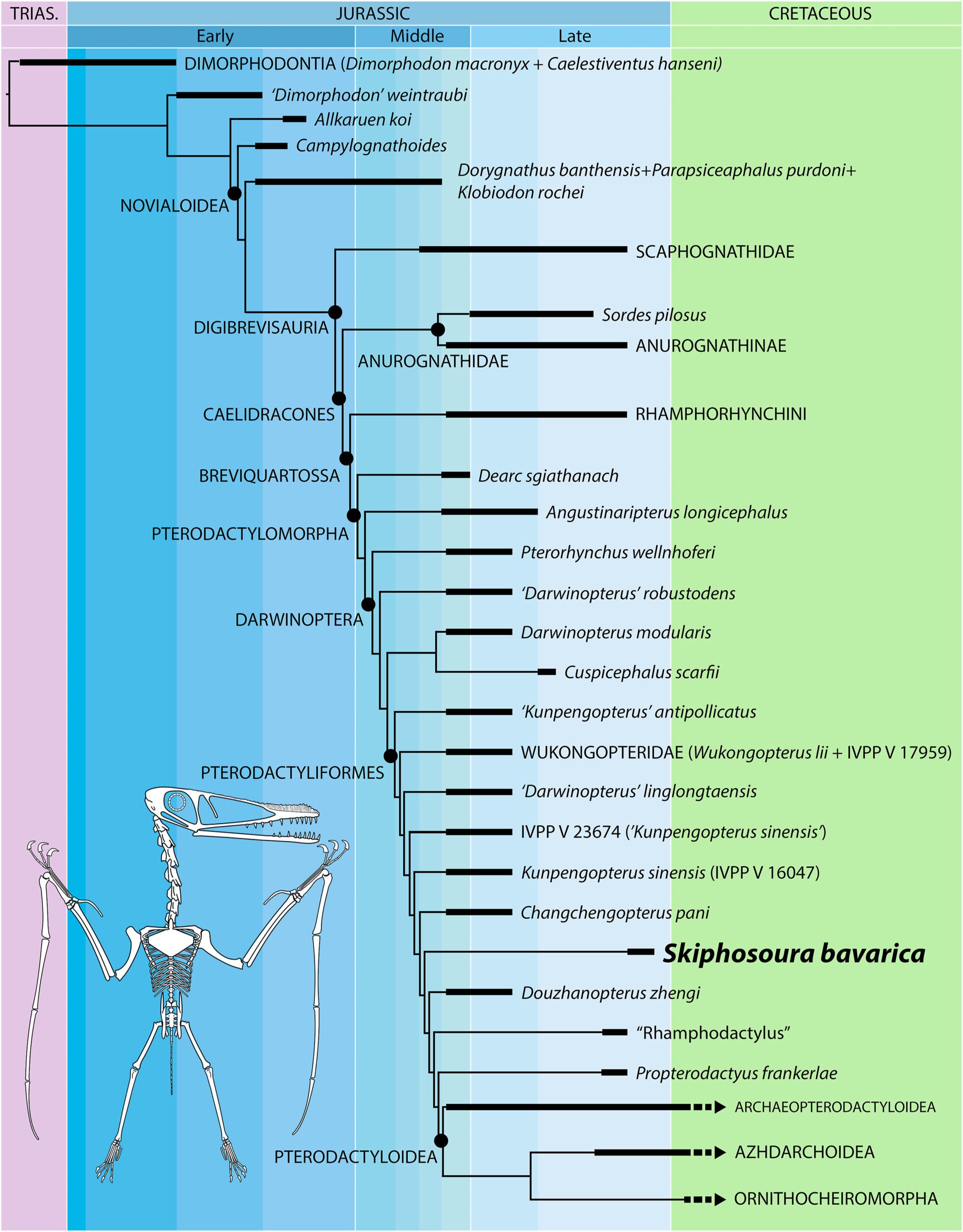Flying reptiles of the prehistoric skies, pterosaurs, are long extinct but continue to reveal the secrets of evolution. These creatures, contemporaries of the dinosaurs, ranged in wingspan from small, birdlike sizes to massive giants reaching 10 meters.
Recent research led by paleontologist Dr. David Hone from Queen Mary University of London, published in Current Biology, unveils a pivotal discovery that bridges significant evolutionary gaps in pterosaur history.
The newly described species, Skiphosoura bavarica, meaning “sword tail from Bavaria,” sheds light on the transition between early and advanced pterosaurs.
Unearthed in southern Germany, the fossil stands out for its remarkable preservation, with nearly all bones intact and three-dimensionally preserved—a rarity among typically flattened pterosaur specimens. With a wingspan of about two meters, it rivaled modern large birds like the golden eagle.

For over two centuries, paleontologists have classified pterosaurs into two primary groups: the early non-pterodactyloids and the later, larger pterodactyloids. Early species featured compact heads, short necks, long tails, and a distinctive fifth toe. In contrast, pterodactyloids exhibited elongated heads and necks, shortened tails, and changes in wrist structure.
Intermediate species, called darwinopterans, discovered in the 2010s, provided a glimpse into the evolutionary transition. These species displayed advanced head and neck features but retained other primitive characteristics. However, questions lingered about the evolutionary steps leading to and following these changes.
Skiphosoura fills this gap. It exhibits traits that blend darwinopteran and pterodactyloid characteristics. The species features a head and neck similar to pterodactyloids but also shows a longer wrist and a shorter tail and toe than earlier darwinopterans. These features provide a clearer view of how evolutionary changes occurred incrementally rather than in sudden leaps.
Related Stories
The study also reconstructed the pterosaur family tree, placing Skiphosoura evolutionarily between darwinopterans and pterodactyloids. It parallels another important find, Dearc, discovered in Scotland, which bridges early pterosaurs and darwinopterans.
Together, these species map a nearly complete sequence of pterosaur evolution, showcasing gradual adaptations like increasing head size, elongating necks, and shrinking tails.
Dr. Hone emphasized the significance of these findings, stating, “This is an incredible find. It really helps us piece together how these amazing flying animals lived and evolved. Hopefully, this study will be the basis for more work in the future on this important evolutionary transition.”
Notably, both Dearc and Skiphosoura were unusually large for their respective time periods. Their size suggests that the adaptations leading to the immense wingspans of later pterodactyloids began to emerge in these transitional species.

Adam Fitch, from the University of Wisconsin-Madison, highlighted the broader implications: “Pterosaurs have long been symbols of the unique life of the past. Skiphosoura represents an important new form for working out pterosaur evolutionary relationships and by extension how this lineage arose and changed.”
René Lauer of the Lauer Foundation, which contributed to the study, praised the fossil’s detailed analysis. Using digital photography under visible and UV light, researchers could discern minute features invisible under natural light. “This significantly aided in identifying these elements and better analyzing finer details,” Lauer said.
Stefan Selzer, a preparator involved in the project, noted the fossil’s unique features. Having worked on over 60 pterosaur specimens from the Solnhofen limestone, he recognized this one’s distinctiveness. “During the final preparation, I saw that this specimen combined characteristics of both major groups of pterosaurs, with the shortened tail as the most important diagnostic feature,” Selzer remarked.
The discovery of Skiphosoura is a crucial step in understanding the evolution of flight in pterosaurs. It connects evolutionary dots that were once missing, providing a clearer picture of how these remarkable reptiles adapted over millions of years.

As Bruce Lauer of the Lauer Foundation summed up, “The Lauer Foundation is proud to have the opportunity to bring this important specimen to science and further the understanding of pterosaur evolution.”
With Skiphosoura, scientists now have a near-complete evolutionary timeline from early pterosaurs to their advanced descendants. This discovery underscores how even extinct species can illuminate the dynamic processes of life’s evolution.
Flying dinosaurs, distinct from pterosaurs (which were flying reptiles rather than dinosaurs), belong primarily to a group called Avialae, which includes modern birds and their closest relatives.

Several theropod dinosaurs developed adaptations for flight or gliding, showcasing the evolutionary steps toward modern birds.
Microraptor, a small, four-winged dinosaur from the Early Cretaceous (~120 million years ago), was discovered in Liaoning, China. It had long flight feathers on both its forelimbs and hindlimbs, suggesting gliding or limited powered flight. Fossil evidence indicates it was covered in iridescent feathers, likely enabling it to glide between trees.
Archaeopteryx, often called the “first bird,” lived during the Late Jurassic (~150 million years ago) in what is now Germany. It had a mix of reptilian and avian features, including teeth, a bony tail, clawed fingers, and feathered wings. While capable of short bursts of powered flight, it was not a strong flyer.
Anchiornis, from the Late Jurassic (~160 million years ago) of China, was a small, feathered dinosaur with feathers on its arms, legs, and tail. It shows an early stage of wing development, likely enabling controlled gliding rather than true powered flight. Detailed studies of its fossilized feathers revealed black, white, and reddish-brown pigmentation patterns.
Yi qi, an unusual Late Jurassic dinosaur (~160 million years ago) also found in China, had membranous wings supported by an elongated wrist bone, resembling bat wings more than bird wings. Though its flight capabilities are debated, it likely could glide or perform weak flapping flight.
Confuciusornis, from the Early Cretaceous (~125 million years ago) in China, was one of the earliest dinosaurs with a beak instead of teeth. Its skeletal structure was similar to modern birds, though it likely had weaker flying capabilities due to a less developed breastbone for flight muscle attachment.
Caudipteryx, also from the Early Cretaceous (~125 million years ago) of China, was a ground-dwelling dinosaur with feathered arms and tail. While primarily adapted for running, its feathers were likely used for display or thermoregulation rather than flight, representing an evolutionary stage toward flight.
Rahonavis, a small, feathered dinosaur from the Late Cretaceous (~70 million years ago) of Madagascar, had long arms and feathers. Its skeletal structure suggests it might have been capable of limited powered flight.
Sinosauropteryx, another Early Cretaceous dinosaur (~125 million years ago) from China, was one of the first dinosaurs discovered with clear evidence of feathers. These were likely used for display or insulation rather than flight, demonstrating an early stage in feather evolution.
Hesperornis, a Late Cretaceous (~80–90 million years ago) bird from North America, was a flightless, aquatic dinosaur with powerful legs adapted for diving. Although it couldn’t fly, it highlights the diverse evolutionary adaptations of avian dinosaurs.
These flying and feathered dinosaurs illustrate the gradual evolutionary steps from non-avian dinosaurs to modern birds. Feathers initially evolved for insulation, display, or camouflage and were later adapted for flight. The diversity of feathered dinosaurs underscores the complexity of evolutionary paths, blending traits for life on land, in the air, and even in aquatic environments.
Note: Materials provided above by The Brighter Side of News. Content may be edited for style and length.
Like these kind of feel good stories? Get The Brighter Side of News’ newsletter.
The post New fossil discovery reveals how flying reptiles evolved appeared first on The Brighter Side of News.